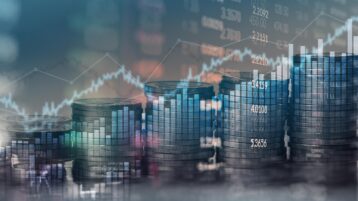The dramatic rise of artificial intelligence has put an investor spotlight on semiconductor stocks that could benefit from its expansion. Julien Nono-Womdim, Semiconductor Analyst at TD Asset Management, speaks with Kim Parlee about the divide between advanced chips and legacy chipmakers.
Print Transcript
[AUDIO LOGO]
*Is the strong demand for all things AI creating a two-tiered chip sector between advanced companies, like NVIDIA, and others? And what does this mean from an investing standpoint?
* Joining me with his thoughts is Julien Nono-Womdim. He's a semiconductor analyst at TD Asset Management. Thanks so much for coming in.
* Hi, Kim. Thanks for having me.
* Let's start with the numbers. When you take a look at NVIDIA's results, the fact-- and I think I was chatting with you earlier, the numbers came out, and I'm thinking, given the stock's meteoric rise--
* Yes.
* --it's baked in. And then they come out and they guide higher.
* Yes.
* And you talk about, you know, the huge demand. So there's a lot of demand still for the AI chips. I mean, it's not hype at this point. There's still much more coming.
* Well, let's think about the industry dynamics. Within semiconductors, there are two tiers of companies. And that's been the case for many years.
* On the one hand, you have the innovators. And these companies, they're like fighter jets. They innovate. They try to make semiconductors faster and more powerful. And NVIDIA is one of them. Intel is actually another one. AMD, as well.
* And on the other hand, you have large industrial companies, call it the legacy companies. And these companies, they're not fighter jets. They're like boring airlines. And their job is to compete on cost and scale.
* And there, you have companies like Texas Instruments, ADI, et cetera. What's changed and what's interesting is, within that innovator ecosystem, NVIDIA has taken the leadership position.
* They really have.
* They've enabled AI, and therefore--
* Yeah.
* --yes.
* Is this demand going to run out of steam, though? Because we always see in investing cycles, you know, huge hype, and then kind of, oh, there is lots to come, but maybe not quite as quickly as people thought.
* There are two things with respect to that question. First, on the fundamentals, right, AI is real. It's not going to come for your job just yet, but it is real. And the reason it's real is for many years now, computers have gradually gotten faster and faster, and now they're so fast that they can process data in near real-time, complex data. And in fact, with generative AI, they can return those results to users in a human-readable format. That's the key distinction.
* And it's going to drive productivity for the next several years across a whole host of industries. Then the second implication is, well, what does this mean for us as investors? And as you say, there's many examples of historical hype cycles.
* And the questions that we need to determine is, number one, where are the companies with respect to the expectations of future growth? Are those expectations anchored in reality or hype? And in the case of NVIDIA, for now, those expectations appear to be real, and the company continues to validate that view.
* Yeah, you see press release after press release from companies on AI. I know there was one out from Google and NVIDIA recently. But I mean, they're just churning out. So let's just put NVIDIA aside for a moment. I love the fighter jet analogy. That will help me remember these things. What are some other companies? You mentioned Intel. You mentioned AMD--
* Yes.
* --and some of the other regular planes. But what other companies are you watching in this space?
* Well, again, it's one that I like to break down into two buckets. The first one is, who's actually enabling all of this, right? NVIDIA is the one that comes to mind for all of us.
* The other companies are some companies that are making the networking chips for all these data centers. You have companies like Broadcom. But you also have companies that are making the equipment used to make semiconductors, right? And there you have companies--
* The picks and shovels, right?
* The picks and shovels. And there you have companies like ASML, like KLA-Tencor. And then the other piece is who's benefiting from all of this. And you talked about the Google collaboration. Microsoft recently announced that they're going to be launching a co-pilot for Microsoft 360-- for Office 360. And that's going to drive continued growth for that business, but ultimately, it's going to drive productivity and, hopefully, economic growth.
* Hm. It's hard, I mean, just because there's so much that's been priced in so quickly with some of these. And I think sometimes it's just hard to figure out where-- how do you find value in these companies? You know all this has been priced up, I assume.
* Absolutely. A lot have been priced up. And I think within that innovator bucket that we talked about, I think investors like to think about technology, where is value. Technology innovation happens in a very discontinuous fashion. The winners of yesterday's are probably not going to be the winners of tomorrow. And going back to overpaying for hype, sometimes the market thinks that the winners of today are also going to be the winners of tomorrow.
* An example of that is Intel. They dominated in the PC era. And eventually, they receded, and now NVIDIA is in the leadership position, thanks to AI, again. And we'll have to see if that continues to be the case. And that's a dynamic exercise of reassessing from an investment point of view.
* It's interesting, I think back to all these things about people, who had the biggest chips and the strongest chips, and years ago, that was a conversation about gaming, but who could do the most. And look how it's transitioned into the AI world, in terms of processing power.
* I want to ask you, as well, though, too, about before AI, the conversation was about politics and about security and military applications and US and China and Taiwan. How does that impact the sector's evolution? Because we're seeing some near-shoring. We're hearing of things being built in the States. But I happen to know it's very complicated and costly to build these foundries.
* Yes. Are you asking me to predict what politicians are going to do?
* No. I'm not asking anybody that.
* I think there are a couple of ways to think about it. The first is, on the political side, maybe let's use history as a way to guide us a little bit. In the 1980s-- 1986, to be precise-- the US and Japan agreed to Japan curtailing its export of semiconductors because they were doing it more cost-effectively than the US.
* You fast forward over 30 years later today, and the US and Japan are working closely together. Companies in both countries are working closely together to drive innovation forward. So that's one piece.
* In that time frame, innovation within the industry continued. Today, we have the issue of the US and China. And I think that, over time, companies within the semiconductor ecosystem are going to have to continue to innovate. They will, as they have. And that will translate, most likely, to continued innovation and technology gain not just in the industry, but for the broader economy.
[AUDIO LOGO]
[MUSIC PLAYING]
*Is the strong demand for all things AI creating a two-tiered chip sector between advanced companies, like NVIDIA, and others? And what does this mean from an investing standpoint?
* Joining me with his thoughts is Julien Nono-Womdim. He's a semiconductor analyst at TD Asset Management. Thanks so much for coming in.
* Hi, Kim. Thanks for having me.
* Let's start with the numbers. When you take a look at NVIDIA's results, the fact-- and I think I was chatting with you earlier, the numbers came out, and I'm thinking, given the stock's meteoric rise--
* Yes.
* --it's baked in. And then they come out and they guide higher.
* Yes.
* And you talk about, you know, the huge demand. So there's a lot of demand still for the AI chips. I mean, it's not hype at this point. There's still much more coming.
* Well, let's think about the industry dynamics. Within semiconductors, there are two tiers of companies. And that's been the case for many years.
* On the one hand, you have the innovators. And these companies, they're like fighter jets. They innovate. They try to make semiconductors faster and more powerful. And NVIDIA is one of them. Intel is actually another one. AMD, as well.
* And on the other hand, you have large industrial companies, call it the legacy companies. And these companies, they're not fighter jets. They're like boring airlines. And their job is to compete on cost and scale.
* And there, you have companies like Texas Instruments, ADI, et cetera. What's changed and what's interesting is, within that innovator ecosystem, NVIDIA has taken the leadership position.
* They really have.
* They've enabled AI, and therefore--
* Yeah.
* --yes.
* Is this demand going to run out of steam, though? Because we always see in investing cycles, you know, huge hype, and then kind of, oh, there is lots to come, but maybe not quite as quickly as people thought.
* There are two things with respect to that question. First, on the fundamentals, right, AI is real. It's not going to come for your job just yet, but it is real. And the reason it's real is for many years now, computers have gradually gotten faster and faster, and now they're so fast that they can process data in near real-time, complex data. And in fact, with generative AI, they can return those results to users in a human-readable format. That's the key distinction.
* And it's going to drive productivity for the next several years across a whole host of industries. Then the second implication is, well, what does this mean for us as investors? And as you say, there's many examples of historical hype cycles.
* And the questions that we need to determine is, number one, where are the companies with respect to the expectations of future growth? Are those expectations anchored in reality or hype? And in the case of NVIDIA, for now, those expectations appear to be real, and the company continues to validate that view.
* Yeah, you see press release after press release from companies on AI. I know there was one out from Google and NVIDIA recently. But I mean, they're just churning out. So let's just put NVIDIA aside for a moment. I love the fighter jet analogy. That will help me remember these things. What are some other companies? You mentioned Intel. You mentioned AMD--
* Yes.
* --and some of the other regular planes. But what other companies are you watching in this space?
* Well, again, it's one that I like to break down into two buckets. The first one is, who's actually enabling all of this, right? NVIDIA is the one that comes to mind for all of us.
* The other companies are some companies that are making the networking chips for all these data centers. You have companies like Broadcom. But you also have companies that are making the equipment used to make semiconductors, right? And there you have companies--
* The picks and shovels, right?
* The picks and shovels. And there you have companies like ASML, like KLA-Tencor. And then the other piece is who's benefiting from all of this. And you talked about the Google collaboration. Microsoft recently announced that they're going to be launching a co-pilot for Microsoft 360-- for Office 360. And that's going to drive continued growth for that business, but ultimately, it's going to drive productivity and, hopefully, economic growth.
* Hm. It's hard, I mean, just because there's so much that's been priced in so quickly with some of these. And I think sometimes it's just hard to figure out where-- how do you find value in these companies? You know all this has been priced up, I assume.
* Absolutely. A lot have been priced up. And I think within that innovator bucket that we talked about, I think investors like to think about technology, where is value. Technology innovation happens in a very discontinuous fashion. The winners of yesterday's are probably not going to be the winners of tomorrow. And going back to overpaying for hype, sometimes the market thinks that the winners of today are also going to be the winners of tomorrow.
* An example of that is Intel. They dominated in the PC era. And eventually, they receded, and now NVIDIA is in the leadership position, thanks to AI, again. And we'll have to see if that continues to be the case. And that's a dynamic exercise of reassessing from an investment point of view.
* It's interesting, I think back to all these things about people, who had the biggest chips and the strongest chips, and years ago, that was a conversation about gaming, but who could do the most. And look how it's transitioned into the AI world, in terms of processing power.
* I want to ask you, as well, though, too, about before AI, the conversation was about politics and about security and military applications and US and China and Taiwan. How does that impact the sector's evolution? Because we're seeing some near-shoring. We're hearing of things being built in the States. But I happen to know it's very complicated and costly to build these foundries.
* Yes. Are you asking me to predict what politicians are going to do?
* No. I'm not asking anybody that.
* I think there are a couple of ways to think about it. The first is, on the political side, maybe let's use history as a way to guide us a little bit. In the 1980s-- 1986, to be precise-- the US and Japan agreed to Japan curtailing its export of semiconductors because they were doing it more cost-effectively than the US.
* You fast forward over 30 years later today, and the US and Japan are working closely together. Companies in both countries are working closely together to drive innovation forward. So that's one piece.
* In that time frame, innovation within the industry continued. Today, we have the issue of the US and China. And I think that, over time, companies within the semiconductor ecosystem are going to have to continue to innovate. They will, as they have. And that will translate, most likely, to continued innovation and technology gain not just in the industry, but for the broader economy.
[AUDIO LOGO]
[MUSIC PLAYING]



























